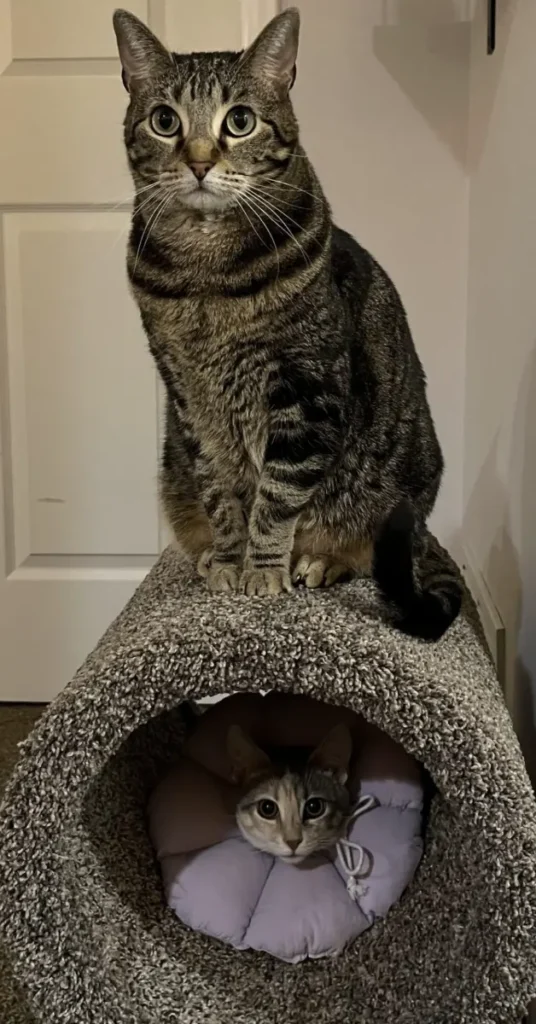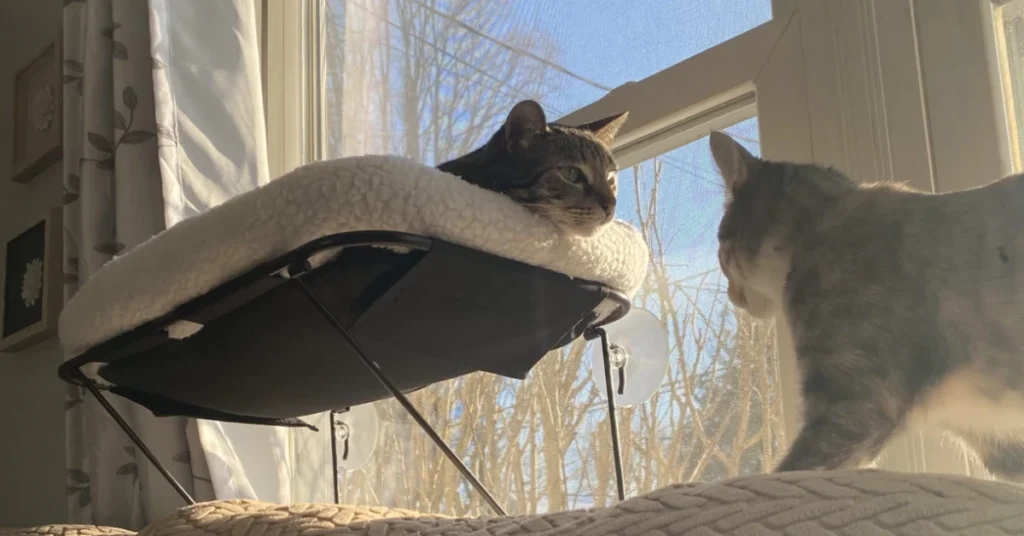
If you’ve recently adopted a new kitten and already have an adult cat (or cats) at home, you are probably a little anxious about the introduction process. This is perfectly natural. Cats can be particularly territorial, especially around a small, spunky, unfamiliar roommate. Fear not, as there are steps you can take to ensure that the process goes as smoothly as possible. Read on to understand territorial behavior in cats and for a step-by-step guide on how to introduce an adult cat to a kitten. With enough patience (and lots of treats), soon enough your furry friends will be besties!
Note: I am not a medical professional, and this article is not to be taken as medical or veterinary advice. Always contact a veterinarian regarding concerns about your pet’s health or behavior. Additionally, Caitycat is a participant in the Amazon Services LLC Associates Program, an affiliate advertising program designed to provide a means for sites to earn advertising fees by advertising and linking to amazon.com. As an Amazon Associate, I earn from qualifying purchases. This post may contain affiliate links, which means I may receive a commission, at no extra cost to you, if you make a purchase through a link. Please see my full disclosure for further information.
Subscribe to my newsletter for all things cats!
Pin it for later!
Understanding Territorial Behavior in Cats
Cats are naturally territorial due to their carnivorous nature, which means in the wild they often have to compete with other animals for their food. Their survival depends on it! Therefore, it goes without saying that these intrinsic traits have followed domesticated cats to the household. When a cat gets comfortable in its own environment, especially if they are an only cat, they oftentimes don’t take nicely to another cat encroaching on their space.
Now imagine a rambunctious little kitten running around that wants nothing other than to play all day. You can see how this could upset your adult cat. Cats typically start to slow down and lose their kitten-energy by the time they reach about 2 years old. They start to appreciate more naps and relaxation time, and a kitten always wanting to play starts to cut into their nap time! Don’t worry though; in most cases, it’s a lot easier to get an adult cat to accept a kitten as opposed to another adult cat. This is because the kitten has not established itself as the ‘head’ of a household yet and will eventually learn to respect the cat’s space.
How to Prepare Your Home for the Introduction Process
First and foremost, you are going to need to set up a space just for the new kitten. Ideally, this should be a big enough space to accommodate a litter box, food/water bowls, scratching posts/towers, toys, a bed, and space to run around. A bedroom would be the ideal size, but you can make a bathroom work too if it’s large enough.
You want to make sure this is a safe space as well, and remove anything that’s not kitten-proof. Make sure there’s not strings or small pieces of jewelry lying around. Ensure there’s no small spaces the kitten could squeeze in and get stuck. Pull up blind cords if you have them, don’t leave human food lying around, and if the kitten’s space is a bathroom, make sure your toilet seat is closed and preferably a toilet lock installed on it, such as the one I currently use: https://amzn.to/4hNXfNB.
This separate space for the kitten is crucial for ensuring the introduction process of your adult cat to your kitten goes well, for reasons that I will expand on in the step-by-step guide for how to introduce your adult cat to a new kitten.
How to Introduce an Adult Cat to a Kitten: Step-by-Step Guide
Step 1: Keep Kitten Separate for 7-10 Days
When you bring your kitten home, you don’t want any eye-to-eye interaction between your adult cat and the new kitten. Place your kitten in the dedicated space you set up for them and keep them there for 7-10 days. This period is not only to make the introduction easier, but also to ensure that your new kitten can’t pass on any illnesses it may have that might not be obvious yet. Kittens can pick up various illnesses in shelters or pet stores, and you don’t want to risk exposing your adult cat until the kitten gets a clean bill of health from your vet.
Step 2: Introduce Smell
Before your adult cat and kitten meet face-to-face, you want to ensure their scents are exchanged. You can do this by allowing your adult cat to sniff under the door of your kitten’s dedicated space.
Another way to help your adult cat and new kitten get used to each other’s scents is by placing a blanket that smells like the other in each other’s space. This allows them to start getting familiar with a new scent being in their environment.
Step 3: Allow Visual Introduction
After you have allowed your adult cat and kitten to exchange scents, you can then allow visual introduction. This part can be a little tricky – I know for me it was when I was introducing my new kitten Hazel to my adult cat Luna. But just remember it is perfectly okay if your adult cat seems to not take to the new kitten right away when seeing them for the first time.
Since you don’t want to allow physical interaction just yet, you can keep a gate between them. You’ll want a tall enough gate that cats can’t jump over, like this one that I have from Amazon: https://amzn.to/4hWIF6B.
Just remember to end the visual introduction if either your new kitten or your adult cat gets too upset!
Step 4: Begin Short Interaction Times
Now that your kitten and your adult cat have smelt and seen each other, it’s time to start allowing short interaction times. The time that you allow your kitten and cat to interact depends entirely on how well it is going. I recommend 20-minute intervals if it seems to be going well and there aren’t any signs of upset or aggression. However, you want to make sure the kitten isn’t out too long, as your house is still a new environment. You don’t want them to get overwhelmed.
Feeding your kitten and your cat together is a great next step during the introduction process. This creates some positive associations, and it will help them both realize that neither are a threat. You can do this by feeding on opposite sides of a door. Or, if you feel like the short interactions are going well, you can feed them together in the same room.
Step 6: Keep Increasing Interaction Times
Now that your kitten and adult cat are beginning to get used to each other, you can start increasing the amount of time they are around each other. Just make sure you keep an eye on their behavior. If they start to show any signs of increasing aggression (more on that below), separate them and try again later.

Building Positive Associations When Introducing Your Adult Cat to a New Kitten
If you want the introduction process between your new kitten and your adult cat to go well, you’ll need to make sure you are continuously building positive associations between them. You can do this by giving them lots of treats if they are behaving while interacting. Remember to always speak in a positive tone as well to reward them both for good behavior.
There are also pheromone products you can buy that imitate a mama cat’s calming signals. I have used Feliway pheromone diffusers around my house during times of stress to calm my kitties. This is a great way to build positive associations while you continue to introduce your adult cat to your new kitten. You can find these diffusers here: https://amzn.to/40MKpIo.
Signs of Aggression to Look Out for When Introducing Your Adult Cat to Your New Kitten
It’s important to know exactly what to look for when introducing your adult cat to your new kitten. It can be a very confusing and stressful time for both of them, and you need to know what’s normal and what’s not.
It is very common for there to be hissing during the introduction process, especially from your adult cat. This is just a form of communication between cats to tell the other to stay away. Hissing may go on for a few weeks, or sometimes even longer. This is okay, as long as it doesn’t escalate to aggression.
Signs of aggression to look out for include a puffed-up tail, ears pinned back, or defensive vocalization. Cats will sometimes even growl, and this is a key indicator that an attack may be imminent. A little bit of swatting if the new kitten gets too close to your adult cat, or vice versa, is normal. However, if your cat or kitten starts to full-on attack, separate them immediately. Don’t try to reintroduce them until both have calmed down.
Steps to Take if the Introduction Process Does Not Go Well
If you follow all the steps above and your furry friends are still not taking to each other, don’t panic! You can start the introduction process over again and take it much slower. Some cats need a lot more time to adjust to a new roommate than others. Continue to read your kitten’s and adult cat’s behavior, and adjust the process accordingly. I will admit, it took much longer than I expected to introduce my kitten Hazel and my cat Luna. There are still times when Luna will hiss at Hazel. However, Hazel knows that this means she needs to give her some space and try again later!
In Conclusion
While it can be a challenging task to introduce your adult cat to a new kitten, there is a light at the end of the tunnel. Patience is key! If you’re not successful the first time around, start the process over and go slower. I didn’t think I would ever get to the point where Hazel and Luna got along. Now, they sleep next to each other on my bed at night and I couldn’t be happier! I have no doubt your cat and new kitten will be best friends in no time.

Did you like this article? Do you have a success story to share about introducing an adult cat to a kitten? Let me know in the comments below!
See also…



